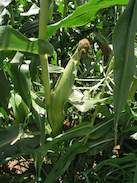
Maize leaves can be affected by various factors ranging from insects through to environmental stressors, such as drought and sunburn, and diseases. Farmers therefore need to determine the cause of symptoms to administer the correct treatment.
Pannar has developed a free smartphone app, called Sprout, to help farmers identify specific diseases in maize production and to better inform their local agriculturalists or chemical consultants of problems.
The company identifies the following as the most common leaf diseases on maize in South Africa:
Northern Corn Leaf Blight
This leaf diseases on maize is a fungal disease that occurs in most of South Africa’s maize producing areas. Symptoms start with lesions usually noticed on the bottom leaves first, which then spread to upper leaves when spores are released.
According to Pannar, the disease usually develops at moderate temperatures – between 18 to 27 degrees Celsius – and at moist conditions and long dew periods. The fungus may cause secondary infections and survives on maize leaf residues.
Common Rust
Common Rust is also caused by a fungal disease and is usually noticed on young maize plants already. This leaf diseases on maize is promoted by moderate temperatures, moist conditions and high humidity.
Signs of infection usually appear five days after spores have germinated and entered the leaves, in the form of small flecks on the leaves. Proper rust pustules usually develop and release spores ten to fourteen days later, according to Pannar. The spores can be distributed over great distances by the wind.
Grey Leaf Spot
Grey Leaf Spot is another fungal disease that primarily occur in areas where there is fog and or high temperatures and humidity, such as in KwaZulu-Natal and the eastern parts of the Highveld.
Symptoms of this leaf diseases on maize are usually most visible around flowering, but may be also be seen earlier at high disease pressures. The disease usually starts at the lower leaves of the plant from where it spreads via spores to newer leaves higher up the plant. The disease is often confused with sunburn and heat stress.
Spores can be spread by the wind or rain, but according to Pannar the real problem is that the fungus can survive for long periods on plant residues.
Bacterial Leaf Streak
This disease, as indicated by the name, is caused by a bacterial infection and usually occurs in the western production areas. The symptoms include interveinal leaf streaks that may be long or short and brown, tan or yellow in colour. The lesions are strikingly yellow when backlit by the sun.
The pathogen is able to survive on crop residues and the may be exacerbated by moist conditions and warm temperatures. Bacterial Leaf Streak disease is often confused with Grey Leaf Spot.
Maize Streak Virus
As indicated by the name, Maize Streak Virus is caused by a viral infection. Pannar describes it as a complex disease that is transferred by leafhoppers. Treatment therefore involves a combination of strategies aimed at limiting infection and targeting the disease carrying leafhoppers.